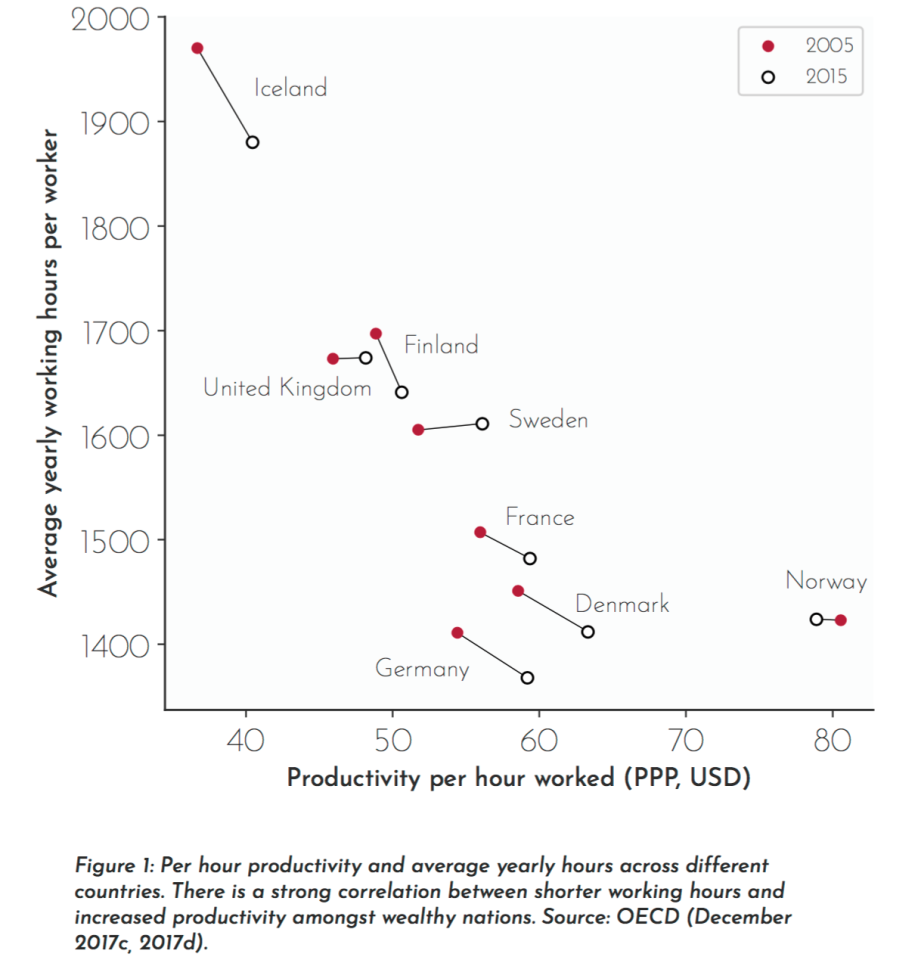Iceland’s short work week trial declared an “overwhelming success”
By Rich Haridy
July 05, 2021

A trial looked at how reducing a work week to 35 or 36 hours affected worker well-being and productivity
johnkwan/Depositphotos
A massive five-year trial in Iceland exploring the effects of a shorter working week is reporting significantly positive outcomes. The results suggest cutting just four or five hours from a standard work week can lead to dramatic increases in worker well-being and improvements in productivity.
The five-day, 40-hour work week was well and truly entrenched in the 20th century. Previously, the industrial revolution resulted in work dominating life to such an unhealthy extent it wasn’t unusual for people to work 16 hours a day, six days a week. Across the late 1800s demand for better regulation of work hours ultimately culminated in US federal laws setting the maximum work week at 40 hours, with overtime for hours worked beyond that threshold.
More recently there has been a growing push to again cut our standard work week down. This primarily has come from several prominent “four-day week” experiments, showing great benefits in cutting the work week down from five days.
A significant New Zealand trial in 2018 found widespread improvements in productivity and worker engagement after asking workers to deliver the same output as usual across a four-day work week. Their pay remained the same, the participants simply worked 30 hours across four days instead of 37.5 hours over five days. A Swedish trial saw similar benefits testing six-hour work days.
These experiments with alternative work weeks take a number of forms, from reducing one’s total work hours over five days to cramming extra hours into a four-day week. The Iceland trial demonstrates how broadly a shortened work week can be applied, looking at around 2,500 workers across a variety of industries.
The trial first started small, initiated by the Reykjavik City Council. A few dozen employees were offered 40 hours of pay but directed to only work 35 or 36 hours every week. Early results proved successful and over the subsequent years the trial was expanded to include a number of different workplaces, including schools, hospitals and police.
Across all metrics the experiment was found to be a success. Productivity either improved or remained the same in the vast majority of workplaces trialed. And worker well-being and health dramatically improved.
“This study shows that the world’s largest ever trial of a shorter working week in the public sector was by all measures an overwhelming success,” says Will Stronge, director of research at Autonomy, a UK organization tasked with analyzing the data. “It shows that the public sector is ripe for being a pioneer of shorter working weeks – and lessons can be learned for other governments.”
Unlike other trials testing more strict formulas, such as a specific four-day work week, this trial tasked its participants with finding their own individual ways of making the shorter week work. Some workers took a half day off once a week, others took a full day off every fortnight.
Workplaces changed internal processes to maintain productivity across shorter hours. This manifested in briefer, more focused meetings and new strategies for increased workflows.
Shift workers saw restructured shift patterns, with amended and often flexible start or end times. Even police stations experimented with different work hours, finding benefits to changing conventional shift patterns.
“In a police station, hours for investigative officers were shortened every other week, so that workers would leave one hour early on Monday to Thursday (8:00 to 15:00), and four hours early on Fridays (8:00 to 12:00),” the report states. “The next week they would work longer days (8:00 to 16:00). This way every other week was shortened by eight hours. Staff working around the clock had a different pattern.”
The report notes the key to successfully deploying a shortened work week is, “flexibility in how tasks were completed, how hours of work and shifts were constructed, combined with interest and engagement in the process of shortening hours from the workplace.”
The trial has proved so successful in Iceland that since its completion 86 percent of the country’s entire working population has either directly moved to a shorter work week or been offered that opportunity.
The report notes a significant amount of evidence correlating increased productivity with shorter work hours. It’s unsurprising people feel better when they work less but perhaps what is surprising is how productivity generally increases when people work shorter hours.

As work hours increased between 2005 and 2015 productivity per hour decreased
Alda, Association for Democracy and Sustainability, 2021
Data spanning 10 years reveals most wealthy European countries show productivity per hour dropping as working hours increase. This relationship reverses as work hours reduce, with a correlation often seen between increased productivity and shortened work hours.
Gudmundur Haraldsson, a researcher working on the new report, says the findings from this massive trial present a roadmap for future work reforms, demonstrating how shorter work weeks can improve outcomes for both businesses and individuals.
“The Icelandic shorter working week journey tells us that not only is it possible to work less in modern times, but that progressive change is possible too,” says Haraldsson. “Our roadmap to a shorter working week in the public sector should be of interest to anyone who wishes to see working hours reduced.”
Sources: Autonomy, Alda
 |
| 1933 |
No comments:
Post a Comment